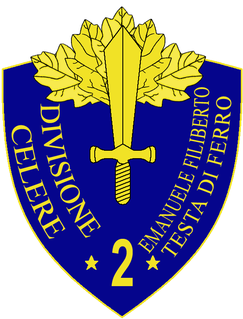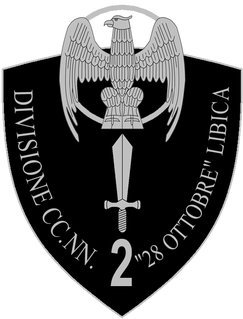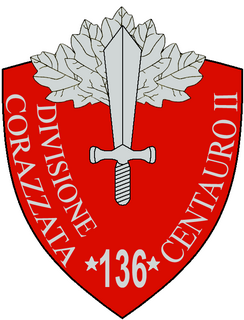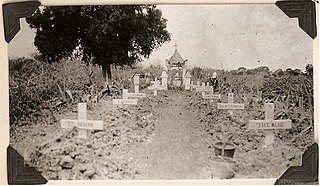 W
WThe 1st Cavalry Division "Eugenio di Savoia" was a cavalry or "Celere" (Fast) division of the Royal Italian Army during World War II. The Eugenio di Savoia was mobilized in 1940 and took part in the Invasion of Yugoslavia. The division was assigned to the XI Corps in Ljubljana and remained in Yugoslavia as occupation force on the Dalmatian coast. After the Armistice of Cassibile on 8 September 1943 the division was disbanded by the Germans.
 W
WThe 1st CC.NN. Division "23 Marzo" was an Italian CC.NN. division raised on 23 April 1935 for the Second Italo-Ethiopian War against Ethiopia. The name "23 Marzo" was chosen to commemorate the founding date of the Fasci Italiani di Combattimento on 23 March 1919. The division took part in the Italian invasion of Egypt and was destroyed during the Battle of Bardia in January 1941.
 W
WThe 2nd Cavalry Division "Emanuele Filiberto Testa di Ferro" was a Cavalry or "Celere" (Fast) division of the Royal Italian Army during World War II. The division was mobilised in 1940, it did not take part in the Italian invasion of France, but did serve in the Invasion of Yugoslavia and remained in Yugoslavia as part of the occupying forces. In March 1942 the division's 6th Bersaglieri Regiment was sent to the Soviet Union attached to the 3rd Cavalry Division "Principe Amedeo Duca d'Aosta". In May 1942 the division started converting to an armored division, however, the conversion was cancelled and it returned to the Cavalry format. In December 1942, the division moved to France as part of the Italian occupying forces where it was based in Toulon. The division remained in France until the Armistice of Cassibile in September 1943, when it returned to Italy, where it was disbanded by the invading Germans.
 W
WThe 2nd CC.NN. Division "28 Ottobre" was an Italian CC.NN. division raised on 10 May 1935 for the Second Italo-Ethiopian War against Ethiopia. The name "28 Ottobre" was chosen to commemorate the Fascist March on Rome on 28 October 1922. The division took part in the Italian invasion of Egypt and was destroyed during the Battle of Bardia in January 1941.
 W
WThe 3rd Cavalry Division "Principe Amedeo Duca d'Aosta" was a Cavalry or "Celere" (Fast) division of the Royal Italian Army during World War II. The division was formed in 1934, and during World War II was mobilized in June 1940. As a cavalry division it took part in the Invasion of Yugoslavia and was part of the Italian Expeditionary Corps in Russia. Annihilated during the Red Army's Operation Little Saturn in December 1942, the survivors returned to Italy in spring 1943.
 W
WThe 3rd CC.NN. Division "21 Aprile" was an Italian CC.NN. division raised on 10 June 1935 for the Second Italo-Ethiopian War against Ethiopia and disbanded shortly before Italy's entry into World War II. The name "21 Aprile" was chosen to commemorate the legendary date of the founding of Rome.
 W
WThe 4th CC.NN. Division "3 Gennaio" was an Italian CC.NN. division raised on 25 June 1935 for the Second Italo-Ethiopian War against Ethiopia. The name "3 Gennaio" was chosen to commemorate the date of assumption of dictatorial powers by Benito Mussolini on 3 January 1925. The division took part in the Italian invasion of Egypt and was destroyed during the Battle of Sidi Barrani in December 1940.
 W
W101st Motorized Division "Trieste" was a motorized infantry division of the Royal Italian Army during World War II. The Trieste was formed in 1939 and named for the city of Trieste. The division and its infantry and artillery regiments were based in Piacenza, while the 9th Bersaglieri Regiment was based until 1940 in Treviso and then moved to Cremona to be closer to the division. The Trieste served in Albania and North Africa where it surrendered to the Allies in 1943.
 W
WThe 131st Armored Division "Centauro" was an armored division of the Italian Army during World War II. It was formed in February 1939, by upgrading the 1st armored Brigade. It took part in operations in Albania, Greece and Yugoslavia before returning to Italy. Sent to North Africa in August 1942, it surrendered in Tunisia on 13 May 1943.
 W
WThe 132nd Armored Division "Ariete" was an armored division of the Royal Italian Army during World War II. It was formed in 1939 as the second Armored Division in the Italian Army after the 131st Armored Division "Centauro". The division fought in the North African Campaign until being destroyed during the Second Battle of El Alamein. After World War II the division was reformed as part of the Italian Army.
 W
W133rd Armored Division "Littorio" was an armored division of the Royal Italian Army during World War II. The division was formed in 1939 from the 4th Infantry Division "Littorio") that had taken part in the Spanish Civil War. It was a reserve unit during the invasion of France, when it attacked through the Little St Bernard Pass, which was halted by the French defenders. It then took part in the Invasion of Yugoslavia, fighting at Mostar and Trebinje. It was sent to North Africa in the spring of 1942 where it fought until it was destroyed in the Second battle of El Alamein in November 1942.
 W
WThe 136th Armored Division "Centauro II" was an armored division of the Royal Italian Army during World War II. The division had a number of different titles before settling on 136th Armored Division "Centauro II". It was formed in 1942 and started as the 1st CC.NN. Armored Division "M", was re-designated 136th Armored Division "M", then 136th Legionary Armored Division "Centauro", and finally "Centauro II". In September 1943 it was in training near Rome and fought the Germans as part of the Corpo d'Armata Motocorazzato before surrendering.
 W
WThe 1st Alpine Division "Taurinense" was a division of the Royal Italian Army during World War II, which specialized in mountain warfare. The Alpini that formed the division are a highly decorated and elite mountain corps of the Italian Army consisting of both infantry and artillery units. Today, the traditions and name of the 1st Alpine Division "Taurinense" are carried on by the Alpine Brigade "Taurinense". The headquarters of the division was in the city of Turin and the majority of its soldiers were drafted from the surrounding Province of Turin — therefore the division was named "Taurinense" for the Roman name of the city of Turin Augusta Taurinorum.
 W
WThe 2nd Alpine Division "Tridentina" was a division of the Royal Italian Army during World War II, which specialized in mountain warfare. The Alpini that formed the divisions are a highly decorated and elite mountain corps of the Italian Army comprising both infantry and artillery units. The name Tridentina was chosen as the division was based in the Trentino-South Tyrol region, for which the fascist regime of Benito Mussolini had created the neologism Venezia Tridentina. After World War II, the traditions and name of the 2nd Alpine Division "Tridentina" were carried on by the Alpine Brigade "Tridentina".
 W
WThe 3rd Alpine Division "Julia" was a division of the Royal Italian Army during World War II, which specialized in mountain warfare. The Alpini that formed the divisions are a highly decorated, elite mountain corps of the Italian Army comprising both infantry and artillery units. Today the traditions and name of the 3rd Alpine Division "Julia" are carried on by the Alpine Brigade "Julia".
 W
WThe 4th Alpine Division "Cuneense" was a division of the Royal Italian Army during World War II, which specialized in mountain warfare. The headquarters of the division was in the city of Cuneo, and the majority of its Alpini soldiers were drafted from the surrounding Province of Cuneo - hence the division's name "Cuneense". The division participated in all Italian World War II campaigns with the exception of the North African Campaign. The division was annihilated during Operation Little Saturn by Soviet forces in January 1943.
 W
WThe 5th Alpine Division "Pusteria" was a division of the Royal Italian Army during World War II, which specialized in mountain warfare. The Alpini are a mountain infantry corps of the Italian Army, that distinguished itself in combat during World War I and World War II. The division was formed in 1935 and based in the Puster Valley, which gave the division its name.
 W
WThe Italian Somali Divisions were two divisions of colonial soldiers from Italian Somaliland that were formed as part of the Italian Army's Royal Corps of Colonial Troops during World War II. In the Royal Corps of Colonial Troops, the units comprised the "101 Divisione Somala" and "102 Divisione Somala", and fought during the East African Campaign in 1941 before disbanding.